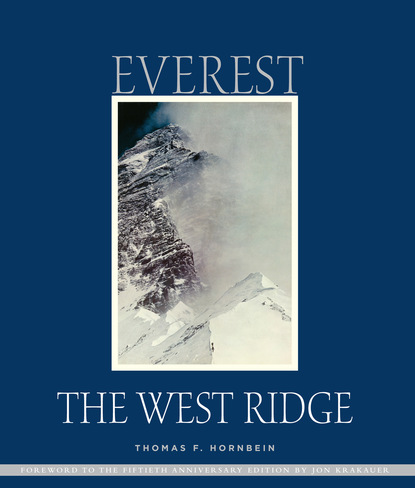|
|
That anyone should want to climb a high mountain solely for pleasure, is, at the present time, simply not understood by these mountain peasants. The exceptions are a few Sherpas who have developed a feeling for the beauty of the mountains and have discovered the pleasure of conquering peaks, owing to repeated participation in expeditions. This is especially true in the case of my own Sherpa, Aila, who was my companion for seven years. Often when we were sitting on a summit with a magnificent panorama spread out before us, he would say very dryly, “Very much country, sir.” This was his way of expressing his pleasure at the wonderful view. Latterly he went so far as to say, “Very beautiful country, sir.” There was a wealth of enthusiasm behind these terse remarks. |
—TONI HAGEN
EVEREST
The West Ridge
THOMAS F. HORNBEIN
FOREWORD BY JON KRAKAUER
| A LEGENDS AND LORE TITLETHE MOUNTAINEERS BOOKS |
Published by The Mountaineers Books
1001 SW Klickitat Way, Suite 201
Seattle, WA 98134
© 1980, 2013 by Thomas F. Hornbein.
Foreword © 2013 by Jon Krakauer
Map © 2013 by Dee Molenaar
Design by Jane Jeszeck, www.jigsawseattle.com
All rights reserved.
Original edition © 1965 The Sierra Club, San Francisco.
COVER: Photo by Barry Bishop/© 1963 National Geographic Society PAGE 1: Puffing up the Hornbein Couloir, with Rongbuk Glacier and Changtse in the background (Photo by Al Auten) PAGE 2: Hongu Basin peaks and Ama Dablam from near Pheriche (Photo by Norman G. Dyhrenfurth) PAGE 3: Detail of glacier below Lingtren–Khumbutse col (Photo by James Lester) PAGE 4: Drummer boy, Kathmandu (Photo by James Lester) PAGE 5: Children herding goats (Photo by Richard M. Emerson) PAGE 6: Sherpani and falling snow (Photo by James Roberts) PAGE 7:A porter waiting on rain (Photo by James Lester) PAGE 8-9: Upper North Face of Everest showing West Ridge, West Shoulder, and the Hornbein Couloir (Photo by Jake Norton) PAGE 10-11: Hongu Peaks from near base of Ama Dablam (Photo by Norman G. Dyhrenfurth) PAGE 12-13: Kangtega and Tamersku from Thami (Photo by Norman G. Dyhrenfurth)
Library of Congress Cataloging in Publication Data Hornbein, Thomas F., 1930- Everest : the west ridge / by Thomas F. Hornbein; foreword to the fiftieth anniversary edition by Jon Krakauer. — Fiftieth anniversary ed.
p. cm.
ISBN 978-1-59485-707-2 (hardcover)
1. Mountaineering—Everest, Mount (China and Nepal) 2. Everest, Mount (China and Nepal)—Description and travel. I.Title.
GV199.44.E85H67 2013
796.522095496—dc23
2012036254
…Until one is committed there is hesitancy, the chance to draw back, always ineffectiveness. Concerning all acts of initiative (and creation), there is one elementary truth, the ignorance of which kills countless ideas and splendid plans: that the moment one definitely commits oneself, then Providence moves too. All sor ts of things occur to help one that would never otherwise have occurred. A whole stream of events issues from the decision, raising in one’s favour all manner of unforeseen incidents and meetings and material assistance, which no man could have dreamt would have come his way. I have learned a deep respect for one of Goethe’s couplets:
Whatever you can do, or dream you can, begin it. Boldness has genius, power, and magic in it.
—W.H. MURRAY
To friends and family who have shared my passionate affair with high places and thin air.
You know who you are.
Girl in doorway, Kathmandu (Photo by James Lester)
A temple and prayer flags in Bodnath (Photo by Tom Hornbein)
Sisters in Those (Photo by James Lester)
FOREWORD
by Jon Krakauer
Most present-day climbers who attempt Everest start trekking to the mountain after flying to a Nepalese village called Lukla. Perched 9,500 feet above sea level, boasting an airport that handles fifty or more flights a day during prime trekking season, Lukla is situated just thirty miles from Everest Base Camp. In 1963, however, when the American Mount Everest Expedition (AMEE) embarked for the Himalaya, there was no airport in Lukla, or even a dirt landing strip, and the nearest road ended a few miles outside of Kathmandu. For the AMEE, getting to the base of Everest entailed 200 miles of hard walking.
On the third evening of their month-long trek, the climbing team assembled to discuss the expedition’s goals. Their primary objective had always been to make the first American ascent of Everest, by way of the South Col—the route pioneered by Tenzing Norgay and Edmund Hillary a decade previously. Prior to 1963, six men had climbed the world’s highest mountain via the South Col, and three others had reached the summit by the Northeast Ridge, on the Tibetan side of the massif. To a small cohort of the AMEE climbers, the prospect of reascending the South Col route seemed like small beer. Willi Unsoeld, Tom Hornbein, Barry Corbet, Dick Emerson, Jake Breitenbach, and a couple of others were much more interested in attempting an entirely new route via the formidable West Ridge—an idea first floated by expedition leader Norman Dyhrenfurth several months earlier.
As the discussion got underway, Hornbein raised his compadres’ eyebrows by proposing that they scrap their plans for the South Col route, which offered a much greater chance of success, and instead direct the full brunt of the expedition’s resources at the West Ridge, even if it meant failing to put anyone on the summit. Although Dyhrenfurth quickly shot down Hornbein’s suggestion, the team agreed to try the West Ridge as a secondary objective, after the summit had been reached by the South Col. Following the meeting, Dyhrenfurth noted in his diary that if they
